The Nearly Perfect 10 Day Trip to Myanmar – Leg 1: Yangon
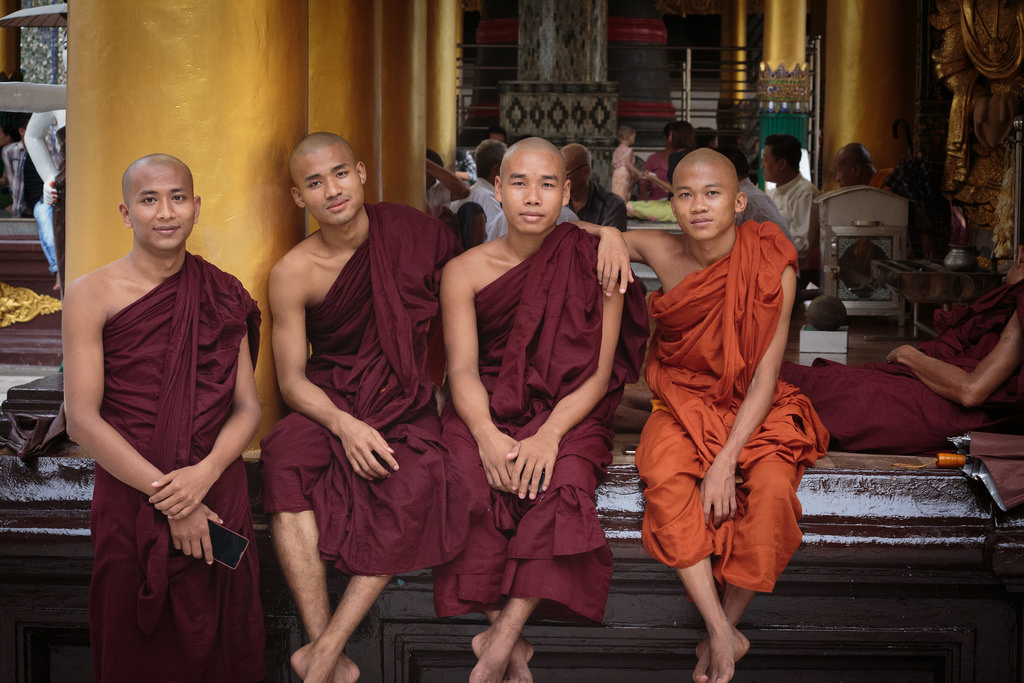
Sadly, due to recent events, I’m adding this note and suspending the series before completing Part III. In October and November 2016, an increase in violence in the northern regions has led to a number of village burnings and significant loss of life. As a result, I encourage anyone considering a visit to research events and the current status before making any decisions. For the time being, it looks like many of the recent gains made are being eroded.
When we decided to visit Myanmar, we wanted to explore a country we knew very little about. You can read up on all of the misconceptions we had before going in this post.
We wanted to see Bagan, visit the amazing temples there, and to catch the one-legged paddling fishermen of Inle Lake if possible. Beyond that? We knew very little. The initial plan was to spend around 5 days in-country before continuing on to Laos. Ultimately, we decided to skip Laos completely and instead doubled up our visit to Myanmar.
Myanmar (formerly Burma), is a wonderful country that recently started to open up again to travel. To recap my previous post, it’s; 1) safe 2) easy to get around 3 ) easy to access 4) still very affordable and, 5) already has a comfortable tourist infrastructure. For some familiar with the earthquake in August 2016, the majority of the damage was to repairs that had been made during a controversial series of repairs 10-20 years ago. In essence, it wiped the slate clean. Everything I’ve seen and read says that most of the temples and pagodas impacted are being repaired rapidly and will re-open soon, if they have not already done so.
It’s also worth noting that the famous balloons over Bagan only fly seasonally. So, if you go in July like we did, you will not see them. They’re also extremely expensive. Lastly, we didn’t fly, but apparently most of the material about the internal airlines being extremely unsafe is 2+ years out of date with the Government overhauling things and replacing aged aircraft with new ones.
.
Yangon
With Yangon we were expecting a bustling, loud, moped infested, smelly, impoverished capital city. What greeted us was an extremely clean city where mopeds and motorcycles are completely banned. We stayed in a small hostel just off of China Town which was the perfect spot for getting around. The taxi in from the airport was well regulated, no-nonsense and cost us 8,000 kyat (6.5 dollars or so).
Outside of fairly poor wifi and surprisingly high rates, the hostel was modern and everything a typical modern has to offer. Interestingly, throughout the trip we alternated between hotels and hostels. The hostels were often as/if not more expensive than 2-4 star hotels and usually ran between 10-20 USD a night per person. This might have been in part due to it being off-season, but I suspect it’s more just that they’ve figured out that people want the social atmosphere even if the price is similar to what they’d pay for a hotel room.
We arrived mid-afternoon which let us get settled and then strike out for some street food and to explore a bit before succumbing to our jet lag. China Town provided a wide variety of great street food and an abundance of fantastic food stands, shop stands, stalls, and sea of fruit and vegetables. We tried a variety of different dishes along the way and even though the pricing was usually a bit high by local standards, it was still normally below full-tourist prices. For a visual taste of what it’s like and what we got into, the following playlist has raw-uncut video from various meals throughout the trip.
We dedicated one full day to exploring the city sights which I think is about right. In theory a day and a half, or two days would have been equally comfortable. Outside of China Town, the primary draw and must-see is the Shwedagon Pagoda which sits in a beautiful park. We walked to it, then opted for a taxi back down towards our hostel. In general the rule of thumb seemed to be that any trip inside the city center with a taxi cost around 2,000 kyat, though at times it took one or two before you’d get them to agree.
Shwedagon Pagoda
As we approached the Shwedagon Pagoda complex we passed through a large park. One of the interesting takeaways were the couples which had set up strategically, obscuring their heads with an umbrella, and with their backs to the carefully manicured shrubs. In a country that has quite strict cultural norms surrounding decency, including blurred cleavage on TV, it was interesting and charming to see the way young people were working around the rules.
We landed on a religious holiday, so the Pagoda was swamped with people. However, it handled the crowds easily. If you’ve experienced the Temples in Bangkok it’s quite similar in many ways. However, the Myanese approach still makes it a rich experience. So, either way, it’s well worth setting aside some time to explore. The Pagoda itself is massive. A vibrant gold tower on a hill that has four gated approaches (East, West, South, North). The approaches are long halls with beautiful gold and green pillars which lead up the side of the hill. For parts, you have escalators which tend to create a certain level of anxiety for some of the locals as it’s one of the first times or the first time many have encountered moving stairs before. This marked one of the most clear illustrations for me of just how rapidly parts of Myanmar are advancing.
One of the other standouts, which isn’t specific to Shwedagon, is the use of LED lights in shrines. It’s quite common to see statues or shrines ringed by flashing LED lights in what feel brutally garish and tacky ways. I find this interesting in and of itself, because the introduction of the LED lights embodies the real, integrated, and natural evolution of the Buddhist faith. At a certain level, outside of rich traditions, there’s no reason to only build using traditional materials, and to keep shrines looking the same way they did 1,000 years ago. And yet, to a tourist’s eyes visiting with my own cultural baggage and with a mind-full of pre-conceptions including romanticized depictions of wise old monks, incense, and 1,000 year old buildings – it’s not always the easiest thing to give up.
The other standout about Shwedagon were the number of secondary pagodas. True, you have the massive golden primary pagoda, but surrounding it you also have a series of secondary, smaller pagodas, and stupa which create a forest of buildings. Many are built in wildly different styles and using very different materials.
The sheer number and scale makes it easy to overlook the details as your brain is perpetually drawn to the primary primary Pagoda, but missing out on the others with their own individual stories is definitely a mistake.
One of my favorite sights inside Shwedagon is that of the monks who are able to pass up to a second layer of the pagoda. The result is a dramatic view of monks in their deep maroon robes juxtaposed against the golden spires of the stupa and the main body of the primary pagoda. There weren’t that many that were visible during the course of our visit, but it’s well worth keeping an eye out for, and if you’ve got a longer zoom and are photo-inclined, definitely an opportunity to get a few good shots.
Wandering Yangon
As we explored the old colonial district surrounding China Town one of the things that quickly caught our attention was the lovely mixture of different religious structures. The most surprising stand out was stumbling on a Synagogue, though you also had quite a few Chinese temples, and a scattering of beautiful churches built in a colonial style scattered throughout. The presence of Jewish iconography was also very prevalent in the marketplace, particularly attached to a number of different stand types. It’s not exactly a sight you normally see, let alone expect to see in a Southeast Asian capital, and definitely not in a country like Myanmar where at least part of the negative press has focused on religiously driven conflict.
The region’s climate makes keeping anything pristine nearly impossible. Much of the city is built with old stone or cement. Moss and mold seem to rapidly integrate themselves into all but the most newly constructed or freshly painted structures. In this way I suspect that much of the city looks significantly less well maintained than it actually is – after all, I can’t imagine the cost and effort of constantly re-painting structures every other year. Given the country’s heritage and time spent under British rule, I also can’t help but wonder how accurate all of the depictions are of British lords, merchants, and military officers attempting to sit around while maintaining perfectly crisped whites and khakis. The utter absurdity of it, to whatever extent it’s accurate, goes a long ways towards bogging the mind and the extent we’ll go to for certain rituals.
The old core is built on a simple grid which makes navigating the city extremely straight forward. The absence of motorcycles and mopeds makes navigating the streets easier and more simple with fewer moving pieces to worry about. Street vendors were friendly, helpful and accommodating. It’s hard to put into specifics, but part of the city’s charm for me was navigating the streets. There’s a feeling of uniformity in the utter chaos – the jumble of shops, street stands, first floor workshops, zig-zagging warren of powerlines, balconies, and metal-bar enforced windows. It’s not the type of city you’ll enjoy spending days wandering in aimlessly, but there’s a charm for a few hours or a day lost in the streets as you let your eyes get inundated by subtle shapes, colors, and angles.
Yangon Market (Bogyoke Aung San)
As is common in cities like Yangon, there’s a major central market. The market has some limited food, produce, but largely focuses on textiles, gems, jewelry, antiques, and everything in-between. In total there are a bit more than 2,000 shops spread throughout the market. You’ll find a fun mixture of open stands and active crafts stalls including jewelers making jewelry by hand, small armies of seamstresses sewing and everything in between. You can see our video update from the market here. While it’s common that these types of tourist-heavy markets tend to be be one of the rare places where you find pushy vendors, outside of one annoying juice merchant, we were largely left alone with the vendors being friendly and helpful when we browsed or asked questions, but otherwise content to focus on their phones or daily tasks.
One of the key aspects I liked most about Bogyoke Aung San was that it still has quite a few active craftspeople creating or assembling products. It’s a living, breathing, working market vs. an unloading station for cheap pre-manufactured tourist crap. I wouldn’t set aside a full day to explore it, but it’s a rich experience and fun place to wander around for a few hours. It was also a good opportunity for David and I to purchase a couple Longyi. While prices varied you can get a cheap Longyi for 3,500 with a decent quality one going for 5,000-8,000. More expensive ones start in the 10s and 20s but the quality difference is typically fairly minimal.
The Longyi
One of the stand out aspects of Burmese culture is the Longyi. You’ll find men and women wearing them the majority of the time. The Longyi is great for the climate, super comfortable, and surprisingly easy to manage once you get used to it. When we first arrived I was concerned it was a gimmick, or a bit disrespectful or obnoxious to wear it as foreigners. But, it’s less a piece of formal cultural wear and more a 3rd alternative to pants. It’s also worn more regularly than say, a Scottish kilt, which further reduces any ceremonial associations.
Longyi differ for men and women. For women the fabric tends to be shorter and include straps to tie it around your waist. For men, the Longyi is a circular piece of fabric which is stitched together creating a tube. They generally come in one size which given our dimensions was a little challenging, but should work for most people. You step into the Longyi (or pull it down over your head), and then flatten it, extending it out to either side of your body. Grab a hold, bring the two wings in, twist them over each other, and tuck them in. Despite not using a clip or tying the ends in a knot, the Longyi stays in place and is surprisingly reliable.
One other quite unique quirk is the art of public urination with a Longyi on. It seemed somewhat common for men to use the restroom in the bushes, or in the covered gutters and drainages that run throughout the city. While this is obviously frowned upon, it was common enough that we’d see it periodically, though it wasn’t until a bit later in the trip I realized what was actually happening. The men squat to a kneeling position, and then covered by the Longyi, will pee while squatting and covered by the Longyi. As strange as it may sound, this really shocked me, as it’s quite unusual to see men urinate in the squatting position, let alone while navigating the folds of the Longyi. Impressive and innovative!
Food
While I’m sure there’s a high quality food scene within Yangon, especially with the country’s heritage, we were focused almost entirely on street food. The street food in China Town was mixed. The most common offering were small uncooked or partially skewers which you’d pick and choose from. Then the chef would grill them up for you, making sure everything was properly cooked. This was tasty, and priced a bit more towards tourists than locals. However, most used minimal flavoring on the meats and veg, which made everything taste relatively uniform. Good for the first few times, but a bit bland for my taste beyond that. It’s also reflective of the re-occurring issue I’ve had with things like seafood in Thailand/Myanmar where you may have a great skewer of fresh shrimp or prawns, but ultimately the taste is no where near it’s potential due to the lack of seasoning, salt, flavoring or anything in between.
We also wandered into a few more traditional / authentic shops. These are full of locals, usually smoking, and have widely varying degrees of hygiene. They normally had 1-3 offerings for the day, and these were more soups, rice, and noodles. These tended to have much more flavor, if less diversity, and were also significantly cheaper than the others. A quick eye to how busy a stand is and how hygienic they are makes it easy to pick which places to avoid. They’re usually not completely surprised to see tourists walking in, but it’s also often clear it’s not that regular an occurrence.
The price difference was significant. Where we’d pay 2,000 kyat for two meals and drinks at one of these local stands, we’d easily pay 4-5x that at the more touristic stalls. Of course, composition of the meals was also a bit different with more meat etc. at the stalls, but it was a clear representation of the rapidly evolving stratification within the economy. In general we found the food to be good, but far from amazing, tasty but not memorable. In many ways it reminded me of the street food I’d eaten in Cambodia. For a more detailed look watch our food playlist on YouTube where we sought to document our dining adventures.
Stay tuned for future posts as we continued on to Bagan and Inle Lake before wrapping up our time in Myanmar. You can see my full albums from Yangon here (color) and here (black and white). All shots are taken on a Canon 6D and if you’d like to support the blog, click through the affiliate link the next time you browse on Amazon.
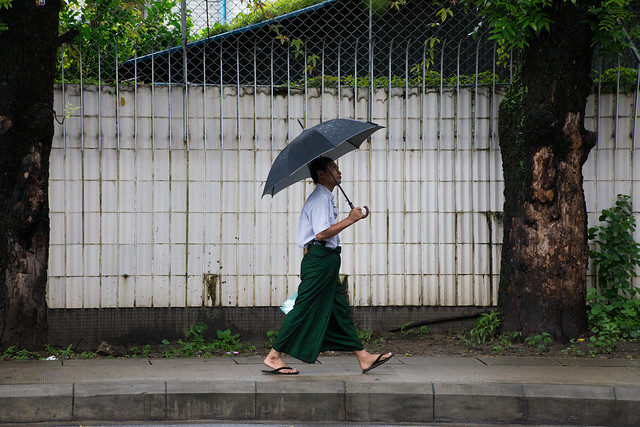
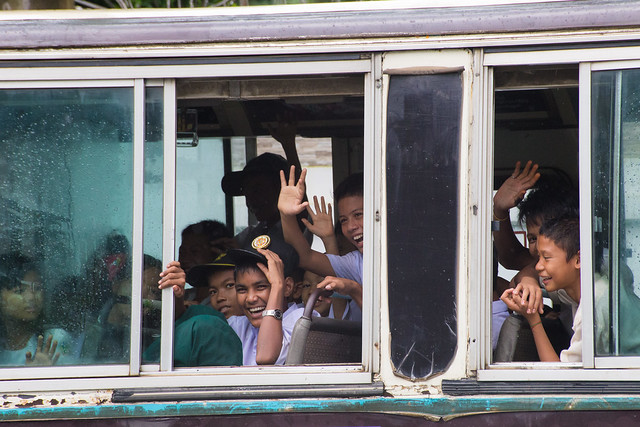
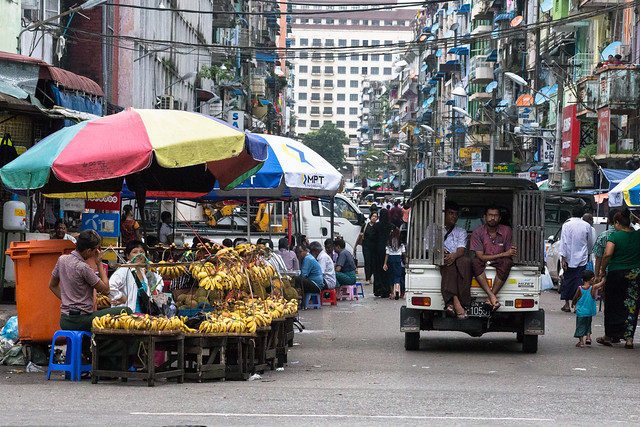
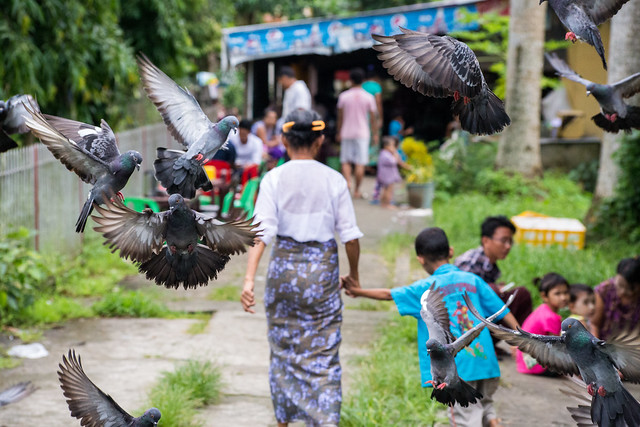
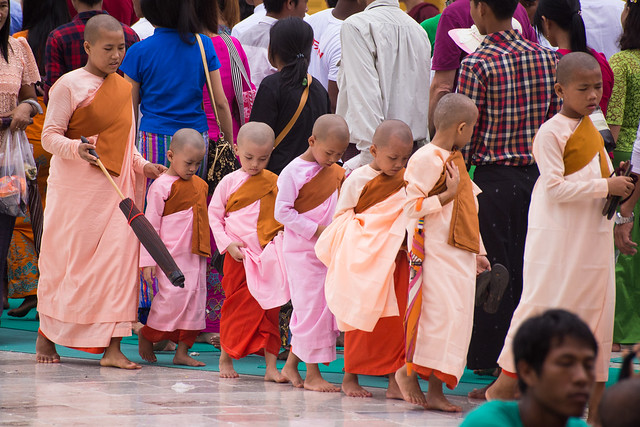
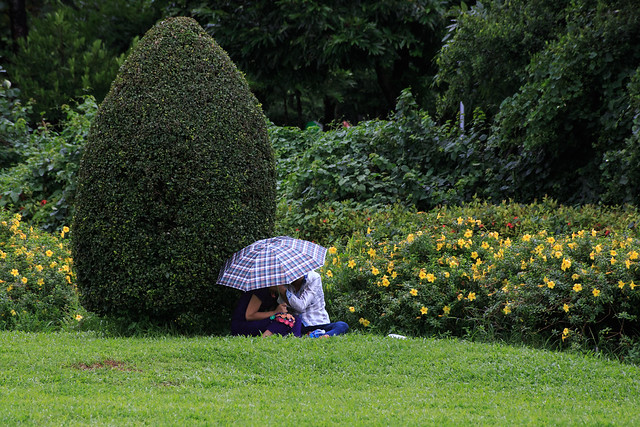
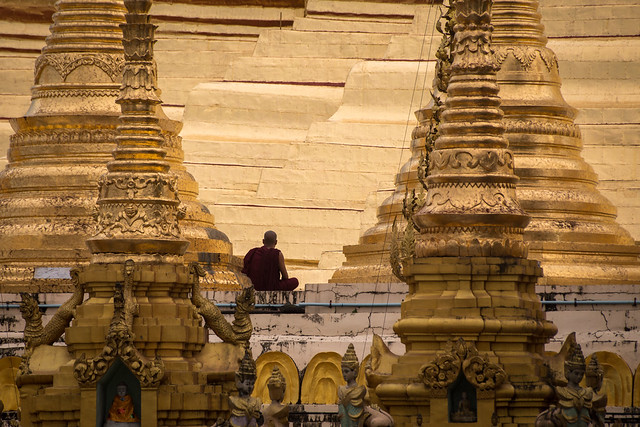
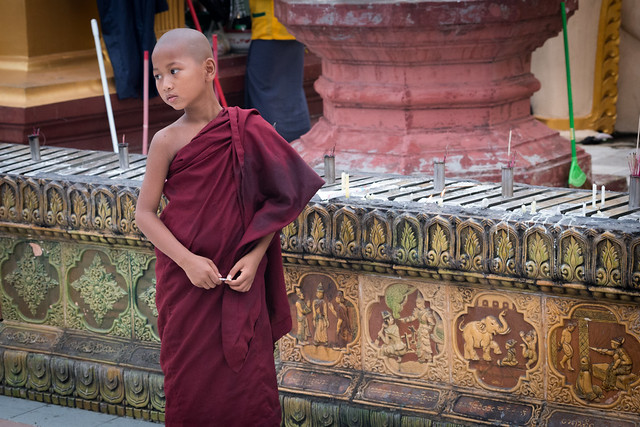
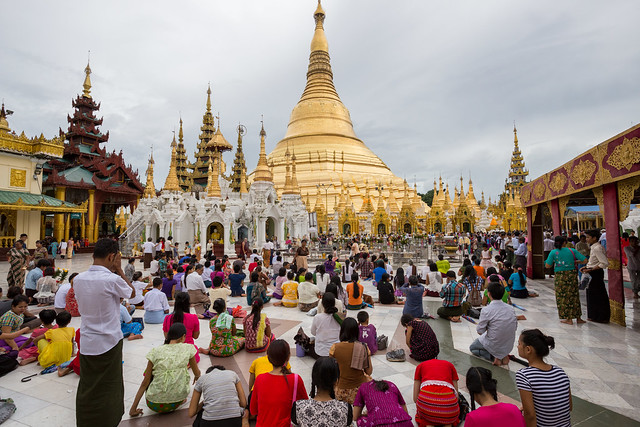
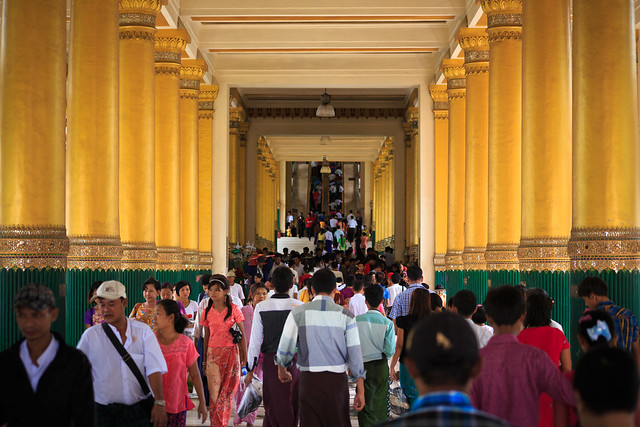
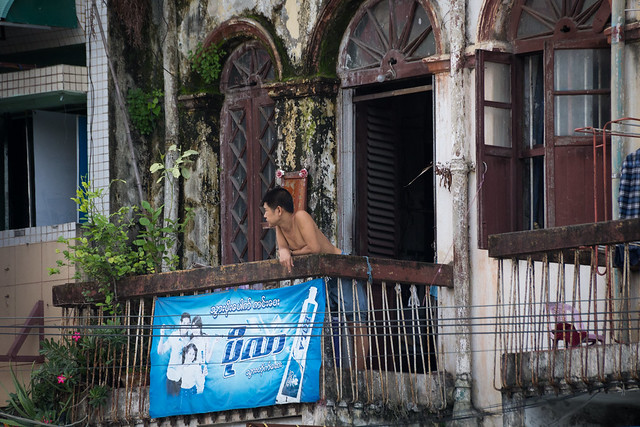
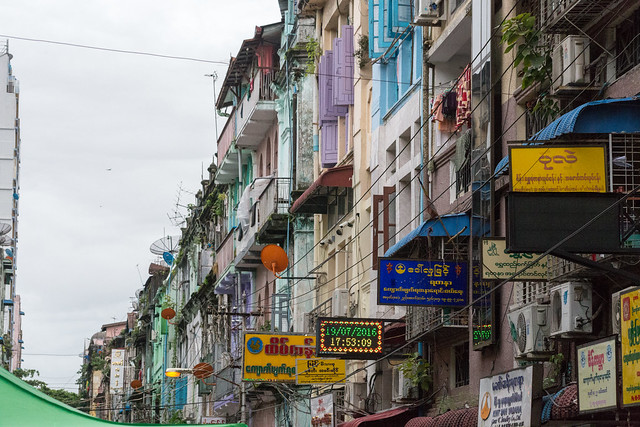
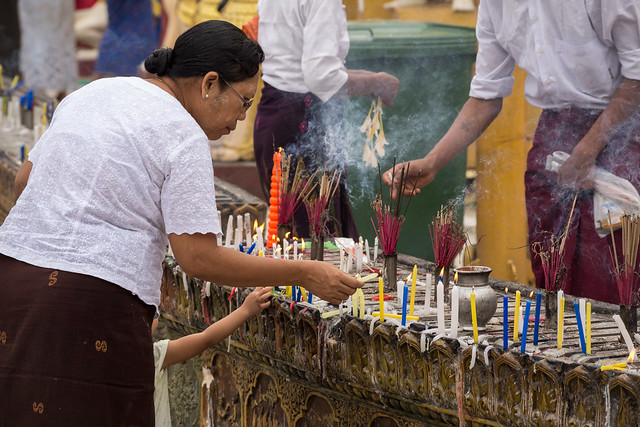
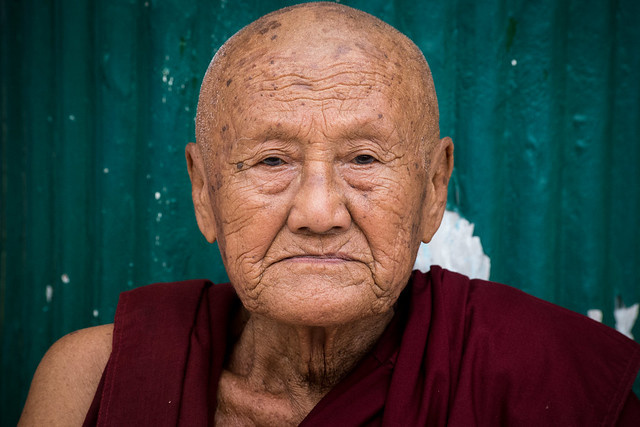
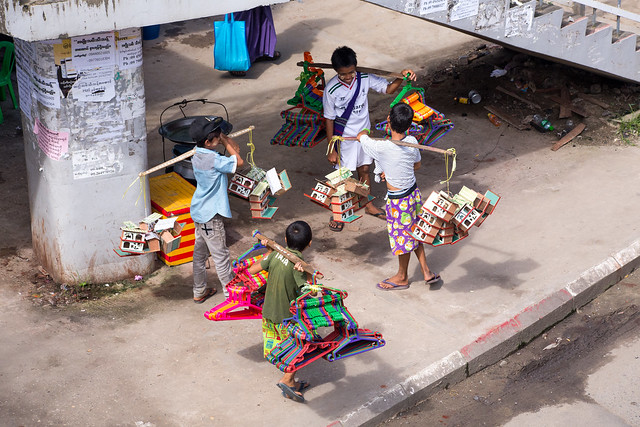
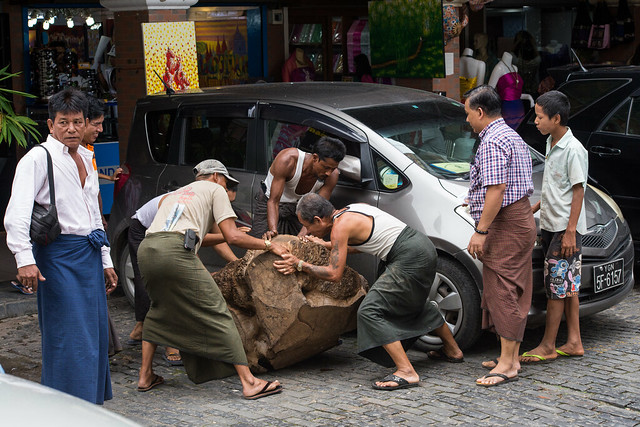
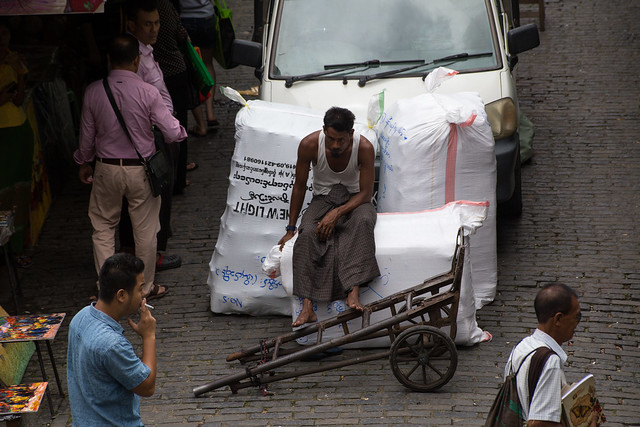
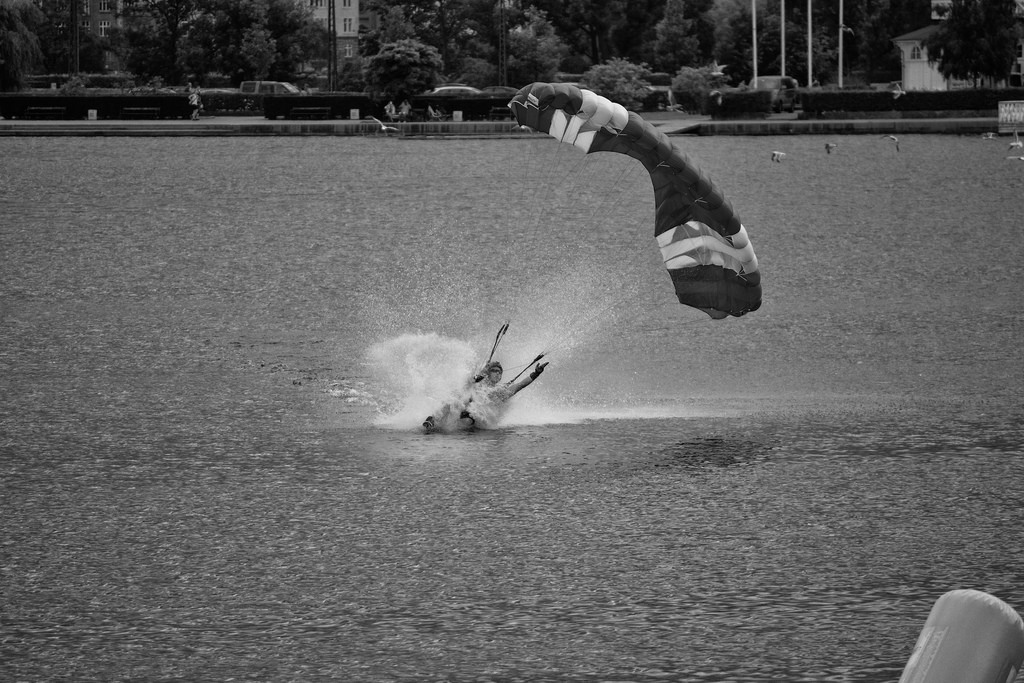
Amazing photos Alex! My husband is in Yangon right now, and after reading your blog post I regret I didn’t join him. Will send him this link.
Thank you! It was definitely a cool city! Very distinct personality! You’ll have to join for the next trip! Will be getting Part II and III up soon!
I love your writing skills and your photography. This post is awesome and selection of photo is too good.
Thanks John =)
Really cool stuff Alex, I really want to go to Myanmar since you started posting so much about it 😉
Thanks! Yeah, it’s definitely gotten me excited. Would love to go back and explore more soon!